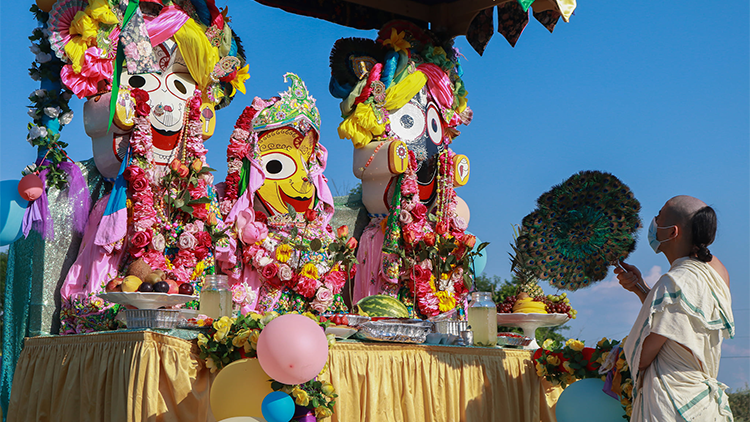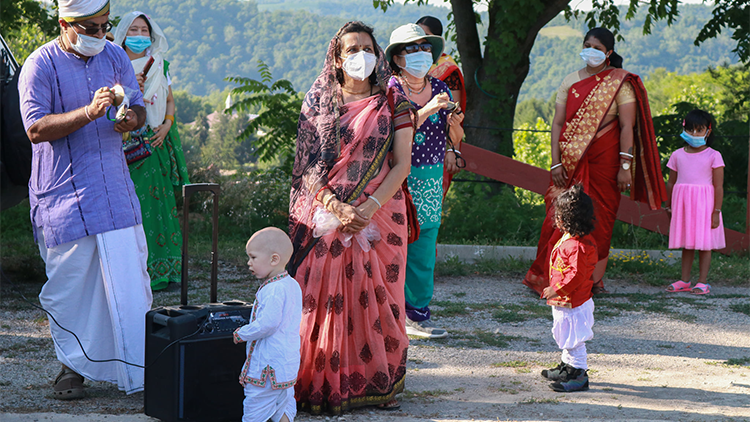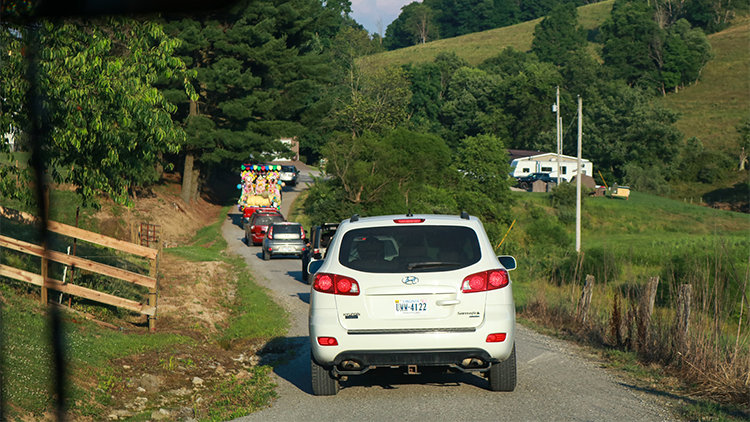New Vrindaban Holds Small Rural Rathayatra with COVID-19 Restrictions
By Madhava Smullen | Июл 24, 2020

Starting in 1973, residents of New Vrindaban, West Virginia, held their own small rural Rathayatra festival on the farm, a sweet event with Lord Jagannath riding a succession of different charmingly rustic makeshift carts.
In the early 2000s, Malati Devi, one of the organizers of San Francisco’s 1967 Rathayatra – the first outside India – commissioned a proper traditional chariot and the festival grew in popularity within the community.
Then in 2016, the Rathayatra became a public annual event in the nearby city of Wheeling, reaching out to the local people and drawing devotees from neighboring cities.
With Wheeling Rathayatra this year canceled due to COVID-19, however, devotees returned to something closer to their early inhouse rural Rathayatra, albeit with restrictions for health and safety amid the pandemic.
Rathayatra is a reunion celebration, with Their Lordships Jagannatha, Baladeva and Subhadra returning to Their devotees after a two-week “sick” leave, and being taken on a pleasure ride in Their chariot. Similarly, this year’s New Vrindaban Rathayatra on July 8th was a reunion of sorts for residents, who had been separated from each other due to COVID-19 lockdown.

Devotees greet Their Lordships at one of the stops throughout New Vrindaban
The event was organized by Malati Devi Dasi, Sachimata Dasi, and Madri Dasi. With Coronavirus safety in mind all elements of the Rathayatra took place outside, with devotees wearing masks, social distancing, and donning gloves when distributing prasadam. In addition, devotees did not pull the chariot together with ropes as is tradition, but instead met Their Lordships’ vehicle in different separate smaller groups at different parts of the 1,500-acre New Vrindaban property.
The “chariot” was Gopisa Dasa’s Dodge Ram pick-up, upon which Tattva-Darshan Dasa had skillfully crafted a gorgeous altar, decorated by Jayasri Dasi and Srimati Nrsinghalaksmi Dasi to look like a beautiful open-air temple.
In a small procession consisting of the chariot-truck along with several devotees’ cars, Jagannath, Baladeva and Subhadra visited six different spots across New Vrindaban.
Beginning at the temple parking lot, they went on to the Ghee Factory by Big Wheeling Creek; Prabhupada’s Palace of Gold; Rupanuga Dasa’s home; Sudhanu Dasa’s home; and “Mystic Valley” in Talavan.

Jagannath, Baladeva and Subhadra tour New Vrindaban with several devotees’ cars in procession
Outside each location, devotees were waiting to greet the Lord. At two stops, an arati ceremony was also performed.
In addition, pre-packed prasadam was distributed to the devotees at each stop. Prepared by expert temple cooks Samardha Krsna and Ananga Manjari, it included a delicious pasta salad made with basil from New Vrindaban gardens, green beans grown in New Vrindaban gardens, and paneer made with milk from New Vrindaban cows, along with strawberry halava.
Co-organizer Sachimata Dasi called the event “very healing” and said, “It’s a very heavy time. So that day was so ecstatic and transcendental. Everybody was just so happy. I think it was just what the doctor ordered, as far as a healing offering to the Lord.”
An article published on New Vrindaban’s website summed it up: “In this festival, there was an outpouring of devotion – from the devotees to the Lord, from the Lord to the devotees, and from the devotees to each other – which was incredibly rejuvenating. Although the temple, the center of our community, had been in lockdown for months, Lord Jagannatha, Baladeva, and Subhadra are so merciful that if you can’t come to see Them, They will come to see you! And this is exactly what They did.
“Travelling to every area of the property, They graced the whole community with Their affectionate glances, and as each devotee stepped forward with heartfelt offerings, there was a wonderful exchange of love which could be felt by all.”















